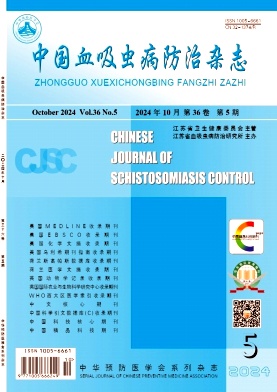[While the priest climbs a post, the devil climbs ten: major biological threats from parasite and vector to malaria control and elimination].
Q3 Medicine
引用次数: 0
Abstract
Malaria is one of the most serious mosquito-borne infectious diseases in the world. The global malaria control progress has stalled in recent years, which is largely due to the biological threats from the malaria pathogen Plasmodium and the vector Anopheles mosquitoes. This article provides an overview of biological threats to global malaria elimination, including antimalarial drug resistance, deletions in the malaria rapid diagnostic test target P. falciparum histidine-rich protein 2/3 (Pfhrp2/3) genes, vector insecticide resistance and emergence of invasive vector species, so as to provide insights into malaria and vector research and the formulation and adjustment of the malaria control and elimination strategy.
[牧师爬上一个岗,魔鬼爬上十个岗:从寄生虫和病媒到控制和消除疟疾的主要生物威胁]。
疟疾是世界上最严重的蚊媒传染病之一。近年来,全球疟疾控制进展停滞不前,这在很大程度上是由于疟疾病原体疟原虫和病媒按蚊的生物威胁。本文概述了全球消除疟疾面临的生物威胁,包括抗疟药物耐药性、疟疾快速诊断检测靶标恶性疟原虫富组氨酸蛋白2/3(Pfhrp2/3)基因缺失、病媒杀虫剂耐药性和病媒入侵物种的出现,以期为疟疾和病媒研究以及疟疾控制和消除战略的制定和调整提供启示。
本文章由计算机程序翻译,如有差异,请以英文原文为准。
求助全文
约1分钟内获得全文
求助全文
来源期刊

中国血吸虫病防治杂志
Medicine-Medicine (all)
CiteScore
1.30
自引率
0.00%
发文量
7021
期刊介绍:
Chinese Journal of Schistosomiasis Control (ISSN: 1005-6661, CN: 32-1374/R), founded in 1989, is a technical and scientific journal under the supervision of Jiangsu Provincial Health Commission and organised by Jiangsu Institute of Schistosomiasis Control. It is a scientific and technical journal under the supervision of Jiangsu Provincial Health Commission and sponsored by Jiangsu Institute of Schistosomiasis Prevention and Control. The journal carries out the policy of prevention-oriented, control-oriented, nationwide and grassroots, adheres to the tenet of scientific research service for the prevention and treatment of schistosomiasis and other parasitic diseases, and mainly publishes academic papers reflecting the latest achievements and dynamics of prevention and treatment of schistosomiasis and other parasitic diseases, scientific research and management, etc. The main columns are Guest Contributions, Experts‘ Commentary, Experts’ Perspectives, Experts' Forums, Theses, Prevention and Treatment Research, Experimental Research, The main columns include Guest Contributions, Expert Commentaries, Expert Perspectives, Expert Forums, Treatises, Prevention and Control Studies, Experimental Studies, Clinical Studies, Prevention and Control Experiences, Prevention and Control Management, Reviews, Case Reports, and Information, etc. The journal is a useful reference material for the professional and technical personnel of schistosomiasis and parasitic disease prevention and control research, management workers, and teachers and students of medical schools.
The journal is now included in important domestic databases, such as Chinese Core List (8th edition), China Science Citation Database (Core Edition), China Science and Technology Core Journals (Statistical Source Journals), and is also included in MEDLINE/PubMed, Scopus, EBSCO, Chemical Abstract, Embase, Zoological Record, JSTChina, Ulrichsweb, Western Pacific Region Index Medicus, CABI and other international authoritative databases.
 求助内容:
求助内容: 应助结果提醒方式:
应助结果提醒方式:


